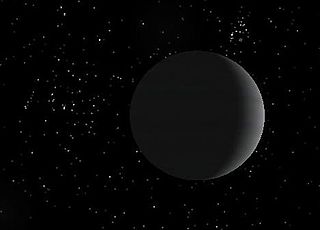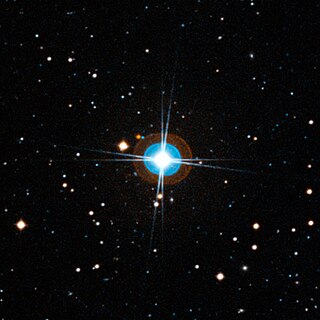Related Research Articles
Mu Arae, often designated HD 160691, officially named Cervantessur-VAN-teez, is a main sequence G-type star approximately 50 light-years away from the Sun in the constellation of Ara. The star has a planetary system with four known extrasolar planets, three of them with masses comparable with that of Jupiter. Mu Arae c, the innermost, was the first hot Neptune or super-Earth discovered.

HD 28185 b is an extrasolar planet 128 light-years away from Earth in the constellation of Eridanus. The planet was discovered orbiting the Sun-like star HD 28185 in April 2001 as a part of the CORALIE survey for southern extrasolar planets, and its existence was independently confirmed by the Magellan Planet Search Survey in 2008. HD 28185 b orbits its sun in a circular orbit that is at the inner edge of its star's habitable zone.
Upsilon Andromedae d, formally named Majriti, is a super-Jupiter exoplanet orbiting within the habitable zone of the Sun-like star Upsilon Andromedae A, approximately 44 light-years away from Earth in the constellation of Andromeda. Its discovery made it the first multiplanetary system to be discovered around a main-sequence star, and the first such system known in a multiple star system. The exoplanet was found by using the radial velocity method, where periodic Doppler shifts of spectral lines of the host star suggest an orbiting object.

47 Ursae Majoris b, formally named Taphao Thong, is a gas planet and an extrasolar planet approximately 46 light-years from Earth in the constellation of Ursa Major. The planet was discovered located in a long-period orbit around the star 47 Ursae Majoris in January 1996 and as of 2011 it is the innermost of three known planets in its planetary system. It has a mass at least 2.53 times that of Jupiter.

Mu Arae b, often designated HD 160691 b, formally named Quijote, is an exoplanet orbiting the star Mu Arae of the constellation Ara.
Mu Arae d, also known as HD 160691 d, formally named Rocinante, is an extrasolar planet orbiting the star Mu Arae of the constellation Ara.

Iota Draconis b, formally named Hypatia (pronounced or ), is an exoplanet orbiting the K-type giant star Iota Draconis about 101.2 light-years (31 parsecs, or nearly 2.932×1014 km) from Earth in the constellation Draco. The exoplanet was found by using the radial velocity method, from radial-velocity measurements via observation of Doppler shifts in the spectrum of the planet's parent star. It was the first planet discovered orbiting a giant star.
Epsilon Tauri b (abbreviated ε Tauri b or ε Tau b), formally named Amateru, is a super-Jupiter exoplanet orbiting the K-type giant star Epsilon Tauri approximately 155 light-years (47.53 parsecs, or nearly 1.466×1015 km) away from the Earth in the constellation of Taurus. It orbits the star further out than Earth orbits the Sun. It has moderate eccentricity.

55 Cancri f, also designated Rho1 Cancri f and formally named Harriot, is an exoplanet approximately 41 light-years away from Earth in the constellation of Cancer. 55 Cancri f is the fourth known planet from the star 55 Cancri and the first planet to have been given the designation of "f".
HD 205739 b is an extrasolar planet located approximately 350 light-years away.
HD 153950 b, also known as Trimobe, is an extrasolar planet located approximately 162 light-years away. This planet was discovered on October 26, 2008 by Moutou et al. using the HARPS spectrograph on ESO's 3.6 meter telescope installed at La Silla Observatory in Atacama desert, Chile.
HD 173416 b, also named Wangshu, is an extrasolar planet located approximately 440 light years away in the constellation of Lyra, orbiting the 6th magnitude G-type giant star HD 173416. This is planet has at least 2.7 times the mass of Jupiter and was discovered on January 10, 2009 by Liu et al. HD 173416 b orbits at 1.16 AU from the star. However, despite the fact that the planet orbits 16% further from the star than Earth does from the Sun, it has orbital period of only 323.6 days, compared to 365.25 days for Earth. This inverse relationship is caused by the parent star having twice the mass of the Sun, which increases the strength of its gravitational field. This evidence implies that when this star was on the main sequence, it was an A-type star.
BD+14 4559 b, named Pirx, is an exoplanet orbiting the K-type main sequence star BD+14 4559 about 161 light-years (49 parsecs, or nearly 1.5×1015 km) from Earth in the constellation Pegasus. It orbits its star within the habitable zone at a distance of 0.777 AU, close to that of Venus, but its star is less energetic, thus its habitable zone is closer to it than Earth. The exoplanet was found by using the radial velocity method, from radial-velocity measurements via observation of Doppler shifts in the spectrum of the planet's parent star.

HD 10180, also designated 2MASS J01375356-6030414, is a Sun-like star in the southern constellation Hydrus that is notable for its large planetary system. Since its discovery, at least six exoplanets have been observed orbiting it, and some studies have proposed up to nine potential planets, which would make it potentially the largest of all known planetary systems, including the Solar System.
HD 192310 c is an exoplanet orbiting the star HD 192310 which is about 29 light years away in the far south-west of Capricornus. It is a Neptune-sized planet and was discovered on 17 August 2011 by the HARPS program.
HD 38283, or Bubup, is a star in the southern circumpolar constellation Mensa. With an magnitude of 6.70, its invisible to the naked eye but can be seen with binoculars. Bubup is located relatively close at a distance of 124 light-years but is recceding with a heliocentric radial velocity of 61.4 km/s.
HD 219134 g, also known as HR 8832 g, is an unconfirmed exoplanet orbiting around the K-type star HD 219134 in the constellation of Cassiopeia. It has a minimum mass of 11 or 15 Earth masses, suggesting that it is likely a Neptune-like ice giant. Unlike HD 219134 b and HD 219134 c it is not observed to transit and thus its radius and density are unknown. If it has an Earth-like composition, it would have a radius 1.9 times that of Earth. However, since it is probably a Neptune-like planet, it is likely larger.
Kepler-419c is a super-Jupiter exoplanet orbiting within the habitable zone of the star Kepler-419, the outermost of two such planets discovered by NASA's Kepler spacecraft. It is located about 3,400 light-years from Earth in the constellation Cygnus. The exoplanet was found by using the transit timing variation method, in which the variations of transit data from an exoplanet are studied to reveal a more distant companion.
HIP 57274 d is an exoplanet orbiting the K-type main sequence star HIP 57274 about 84.5 light-years (26 parsecs, or nearly 8.022×1016 km) from Earth in the constellation Cetus. It orbits within the outer part of its star's habitable zone, at a distance of 1.01 AU. The exoplanet was found by using the radial velocity method, from radial-velocity measurements via observation of Doppler shifts in the spectrum of the planet's parent star.
HD 240237 b is a super-Jupiter exoplanet orbiting the K-type giant star HD 240237 about 4,900 light-years (1,500 parsecs, or nearly 4.6×1016 km) away from Earth in the constellation Cassiopeia. It orbits outside of the habitable zone of its star at a distance of 1.9 AU. The exoplanet was found by using the radial velocity method, from radial-velocity measurements via observation of Doppler shifts in the spectrum of the planet's parent star. The planet has a mildly eccentric orbit.
References
- 1 2 3 4 Tinney; et al. (April 2011). "The Anglo-Australian Planet Search. XXI. A Gas-giant Planet in a One Year Orbit and the Habitability of Gas-giant Satellites". The Astrophysical Journal. 732 (1): 31. Bibcode:2011ApJ...732...31T. doi: 10.1088/0004-637x/732/1/31 .
- 1 2 "Approved names (§ Australia)". Name Exo Worlds. IAU . Retrieved 19 December 2019.